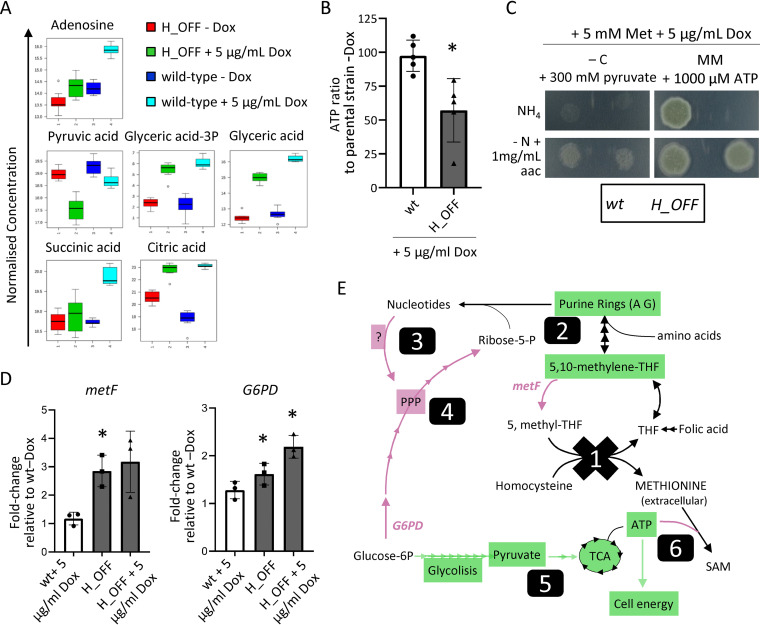FIG 3.
Lack of methionine synthase activity causes a decrease in cell energetics. (A) Normalized concentrations of metabolites in fungal mycelia (n = 8). Adenosine levels were decreased in H_OFF+Dox compared to wild type + Dox (wt+Dox), which agrees with its capacity to partially reconstitute growth. Several metabolites of the glycolysis and TCA pathways were reduced in H_OFF+Dox compared to wt+Dox, suggesting low energetic levels. (B) The levels of ATP significantly decreased in the H_OFF strain upon Dox addition, while they did not vary significantly in the wild-type strain. Each point represents a biological replicate, which was assayed with three technical replicates. Data were analyzed by using a one-sample t test to a hypothetical value of 100 (i.e., no change in ratio of ATP). Graph displays the mean and standard deviations (SD). (C) Pyruvate as the sole carbon source could reconstitute growth of the H_OFF strain in restrictive conditions to wild-type levels. For both strains, growth was limited and slightly improved in the presence of amino acids (aac). ATP could fully reconstitute growth of H_OFF when amino acids were the sole N source. The phenotypic analyses were repeated in three independent experiments. Representative plates are shown. (D) RT-PCR calculation of the fold change in genetic expression of metF and G6PD with respect to their expression in wild type without Dox. Each point represents a biological replicate which was analyzed with three technical replicates. Data were analyzed by using a one-sample t test to a hypothetical value of 1 (i.e., no change in expression). The graphs display the means and SD. (E) Schematic representation of the metabolic imbalance started with MetH repression (1). Lack of the enzymatic activity caused a shortage of 5,10-methylene-THF and consequently of purine rings (2). This was sensed as a shortage of nucleotides that the cell attempted to compensate through an unknown mechanism, seemingly TOR and PKA independent (3), that activated glucose flow through the pentose phosphate pathway (PPP) (4). That caused a reduction of glycolysis and TCA cycles, which in turn decreased ATP levels (5). ATP usage for S-adenosylmethionine (SAM) synthesis was maintained, which caused a drop in cell energy that resulted in growth arrest (6). Genes/pathways/compounds expected to be reduced are highlighted in green and those increased in magenta.

